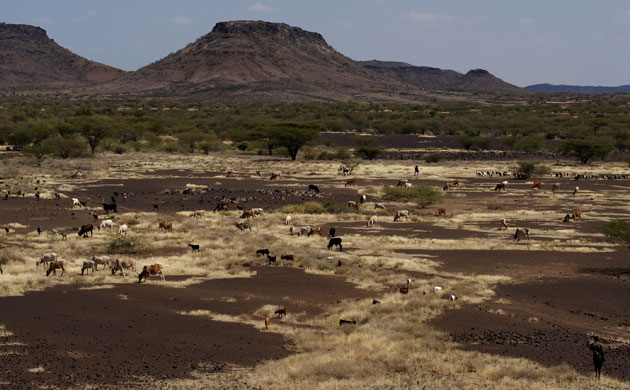Drought drives Kenya herders to the brink
In the isolated border lands between Kenya and Somalia, families have always clung to a precarious existence. Now a decade of droughts has tested their endurance 
By Peter Beaumont in Elwak Hawa Hassan comes leading three donkeys, accompanied by two female relatives and a handful of the family’s smallest children. They have walked out of the drought-withered acacia scrub, travelling 15 miles in a day to reach the Kenyan settlement of Makutano, not far from the border with Somalia. Makutano is a sparse collection of tukuls – dome-shaped dwellings patched with cloth and tarpaulin and sections of woven-grass matting – scattered along the dirt road. Passing through a fence of piled thorn around the settlement, Hawa and the other women unload branches from the donkeys’ backs. Quickly and dextrously they bend and lash the boughs, framing an igloo-shaped structure in a few minutes, one of three that will be erected by the women in a sandy clearing among the low and spiny trees. The men, says 55-year-old Hawa, are a day behind the women with what remains of their livestock – some camels and 18 goats out of the 40 they once owned. The rest perished through lack of water – or were slaughtered for meat so her family could survive a few more days on their journey. As Hawa works the rough twine around the sticks, she describes in a few sentences the story that marks not simply the end for her family of generations of nomadic existence in the isolated lands where Kenya meets Somalia and Ethiopia, but the imminent collapse of a whole way of life that has been destroyed by an unprecedented decade of successive droughts. “We have no water,” she explains, “and no food. We have left the pastures because we have lost so many goats. We had to come here to seek assistance. For the past two months we have talked and talked about making this decision. We waited because we thought there might be some rain.” … What is happening in Kenya’s ranger lands is the slow death of an existence, with families attempting to cling stubbornly to a land where the acacia scrub has been scorched to a spectral grey; where wind erosion scourges the possibility of life out of the fragile, desiccated soil. It has always been a hard living, herding goats, camels and bony cattle on the migration routes between the dry season and the wet season pastures. These days it looks close to impossible: the herders have begun slaughtering what precious stock has survived in order to feed their families. …
The last nomads: drought drives Kenya’s herders to the brink via Apocadocs